Here’s one of the craziest asks that’s hit my inbox in recent months:

There were other contenders, too, but this one takes the cake: The subject line is misleading. The tone is scathing. The match is fanciful. A lot of campaign emails from this election cycle look similar. And prospective donors from across the political spectrum are talking openly about it:
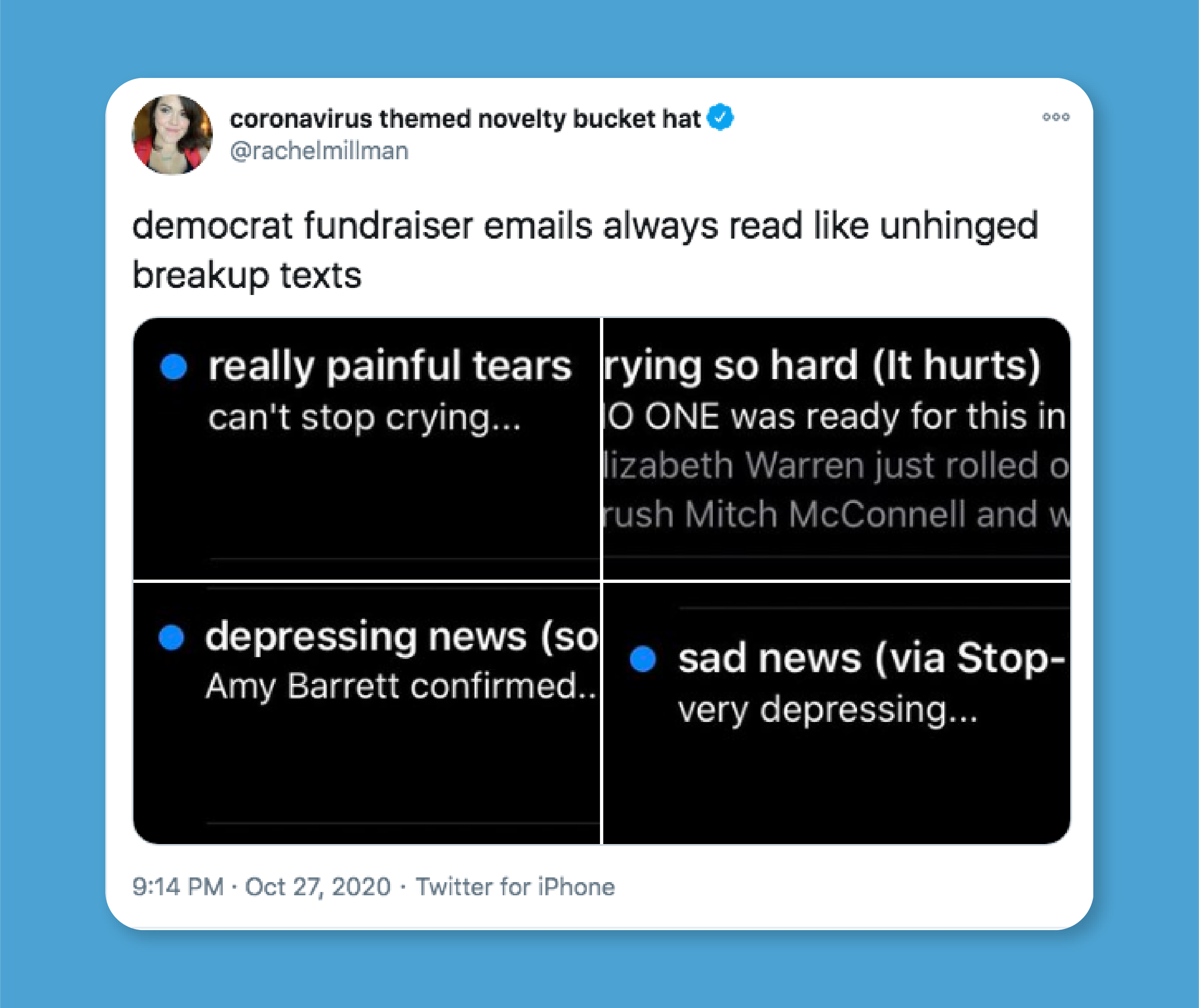
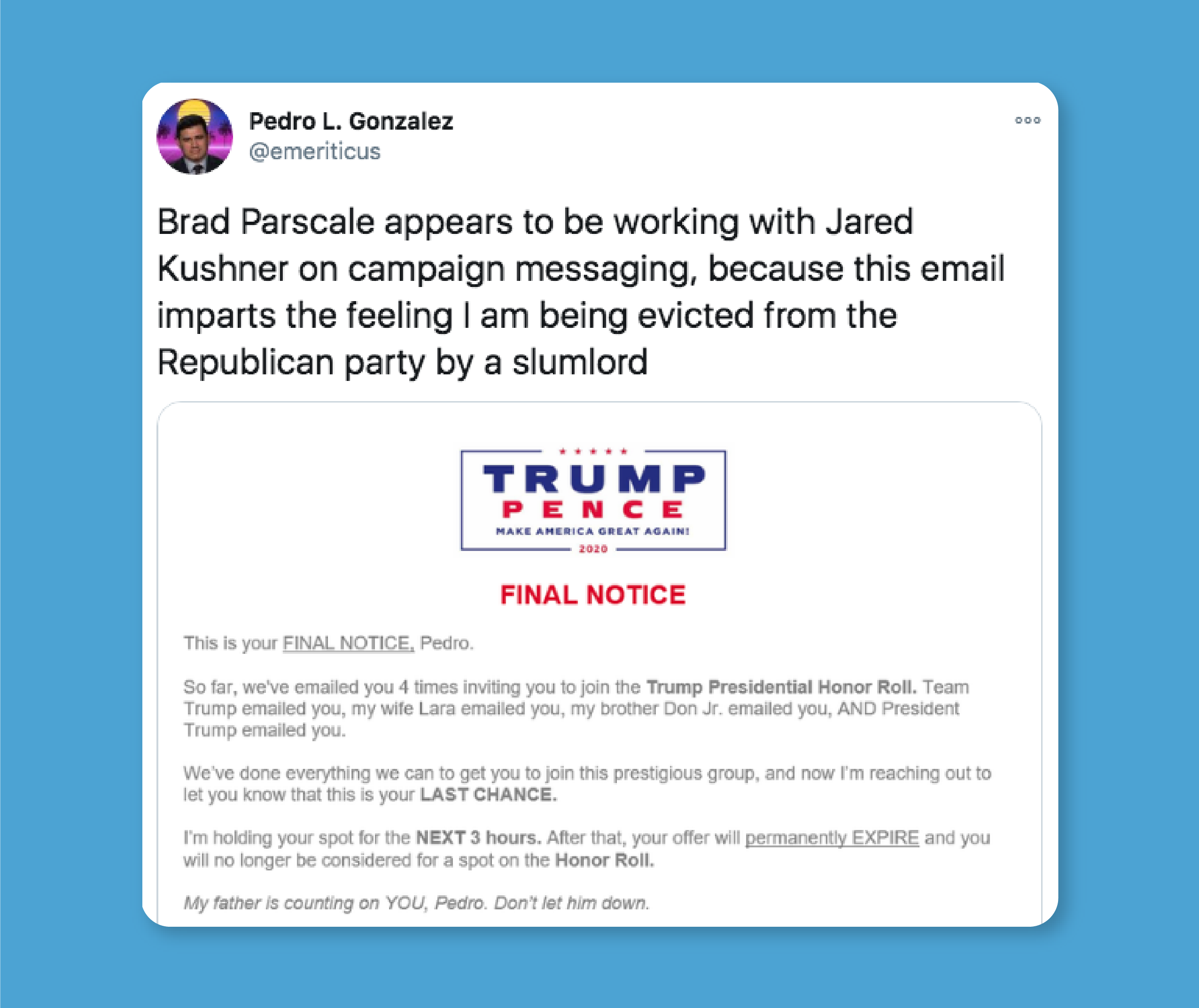
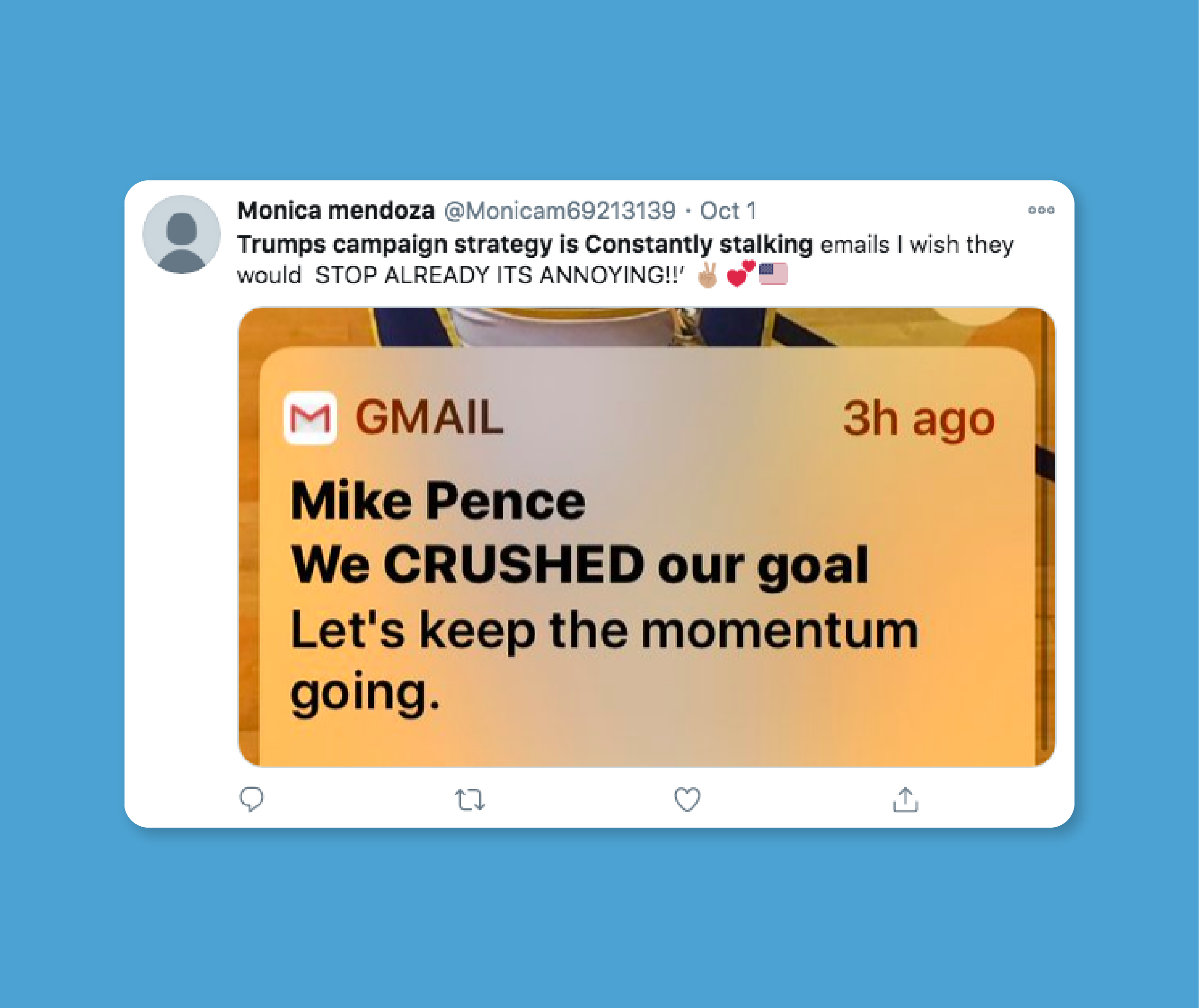
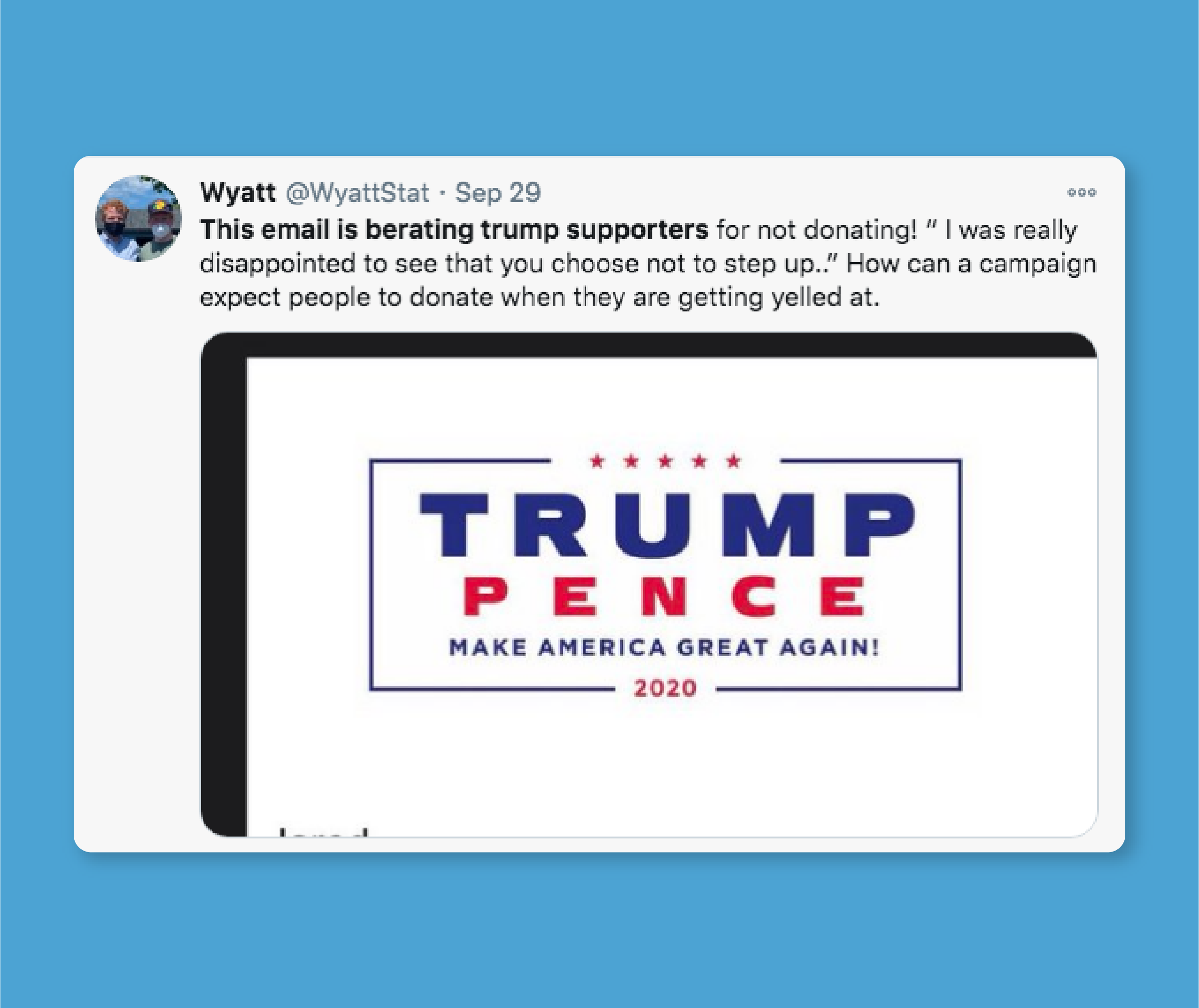
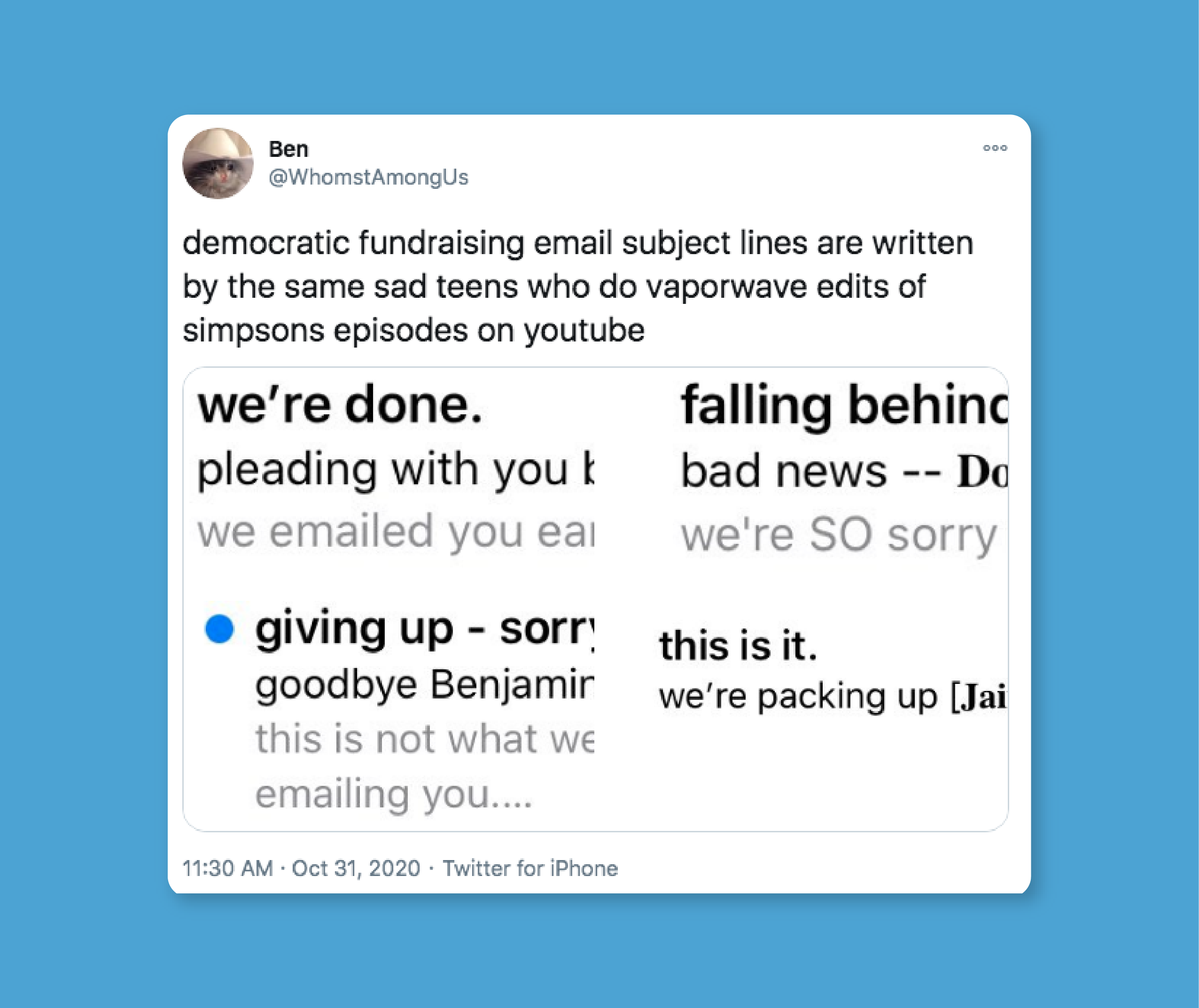
In the weeks leading up to the 2020 presidential election (and now, beyond), fundraising emails — particularly those in hotly competitive or consequential political races — have been the subject of scrutiny from reporters, academics, and practitioners. A study out of Princeton University, for instance, concluded that a vast majority of campaign email programs employ tactics they deem “manipulative” — including deadlines and vanity prefixes (such as re: or fwd:) — in their subject lines on at least an occasional basis.
Often, that’s by design. Any successful fundraising program is going to be focused on optimization grounded in data from its audience. Testing and learning is the guiding force behind these decisions — what we see in our inbox is often the result of hyper-optimized campaigns.
Subject lines are loud because inboxes get crowded, and we need you to PAY ATTENTION. Deadlines exist because movements require momentum — and often are timed with FEC reporting periods. We do what we do because it works…is the simple answer. The less simple answer is that there are different schools of thought around what ‘it works’ means in practice.
When it goes too far
Perhaps the most prominent example of grassroots tactics taken to an extreme is from Donald Trump’s presidential campaign. One Twitter user, @TrumpEmail, has spent years thoroughly tracking the President’s “fundraging” emails, and found that a majority of them use shaming and a guilt-tripping or combative tone.
Numerous articles, like this one from Vox, have sought to analyze and dissect the campaign’s “grifty,” aggressive approach, essentially asking: Why are you yelling?
The answer to that, too, could be because it works — the Trump operation has raised over $268M from grassroots contributions.
But Trump has had to raise a lot of money because he’s spent a lot of money: 77 cents of every dollar raised was being cycled back into its grassroots fundraising arm, Trump Make America Great Again Committee (TMAGA), during the third quarter.
While a burst of spending isn’t uncommon in the final stretches of a campaign, there are indications that the list has burnt out, and that might explain the increasingly ludicrous tactics — which are effective at raising money, but are also effective at turning people off.
It’s a calculation that all campaigns must contend with: immediate ROI with poor retention or long-term ROI with healthy retention. The Trump team chose the former. The effects are all too clear — and linger even beyond the election, as the operation has pivoted to raising funds for Trump’s new leadership PAC, holding fast to the same overbearing formula.
The signs
1. Match Fatigue: The Trump campaign steadily moved from an already-implausible 200% match in earlier 2020 to a 1,000% match just ahead of Election Day. This suggests the list not only expects a match (in October, 91% of Trump fundraising appeals used this tactic), but that exponential multipliers have lost their efficacy — hence, always-on and ever-increasing matches (which, considering campaign finance laws, are almost certainly not real).
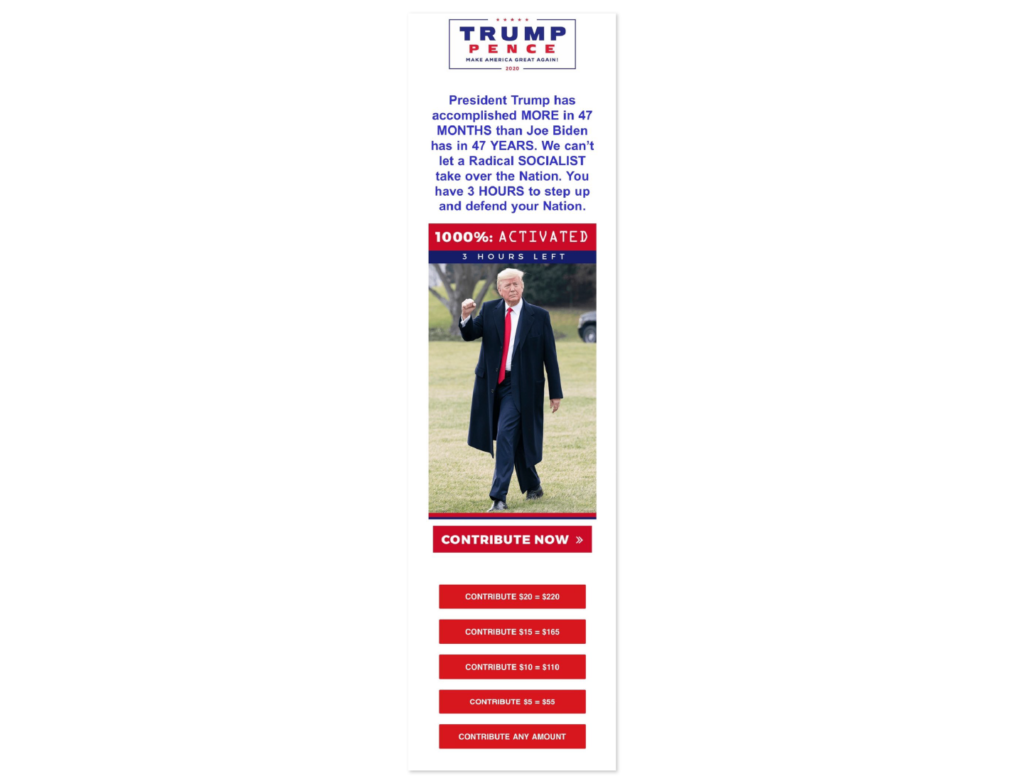
2. Flooding the inbox: Trump averaged 17 emails per day in October — more than three times as many as Biden. The heaviest cadence came on October 31st, climbing to a whopping 27 emails before the end-of-month deadline, some in the wee hours of the morning. This is “churn and burn” (a cycle of quick, cheap acquisition → bombardment with okay returns → high attrition) on steroids.

3. Transactional: An email list is a profit-generator, but it’s also an outreach tool and an energizer. The singular focus on money-in-hand with the fleeting promise of inclusion on a list of top supporters comes at the expense of authenticity and relationship-building — the stuff that gets people bought in for the long haul.
What Trump is doing may be effective for accruing short-term revenue, but isn’t sustainable in the long-term, and the data and program in the campaign’s final stretch show it.
Though Trump may be one of the more infamous adherents to this approach, candidates and organizations on both sides are using dialed-up tactics like this, too. Take an underdog candidate like Jaime Harrison, who — sometimes, but not always — pulled from a similar tactical playbook and met record-breaking fundraising success, though ultimately fell short at the ballot box.
The tactics are the trees
I’ll start by saying this: Your tactics are only as good as the relationships you build. That isn’t to minimize their importance — but if your broader organizational objectives are the forest, the tactics are the trees.
Matches or deadlines or dwindling countdown clocks can enhance results from a supporter base that’s energized, empowered and invested in your cause. And those relationships take time to build and cultivate. How can you do that? Here are a few ideas:
- Present the theory of change: Small-dollar donations can and DO make an impact. It’s critical to explicitly lay out a theory of change: what the opportunity is, why it matters, how a gift today can further a common cause.
- Switch it up: Need and urgency are central to the success of any appeal, but there are different ways to get the point across. Urgent can be serious. It can be passionate. It can be heartbroken. And sure, sometimes you need money now, and it can just be urgent.
- Have a heart: Connections are forged around shared understanding. This year demanded we approach supporter relationships with empathy — broadly and deliberately. And we don’t see that going away.
We see this come to life in a campaign environment with organizations like the DNC, who leverage goals and deadlines on a regular basis, while following the guiding principles above.

In this message, Biden acknowledges the fatigue supporters may be feeling, but justifies the volume through his case for support. Leading with respect and humility makes all the difference.
We also see it in nonprofit partners, like Covenant House:

This email balances the urgent deadline with the strength of community: reporting back on progress made towards an ambitious, highly tangible goal — and more than that, outcomes for youth. The sender makes the message personal. “Let’s make this happen together,” empowers the donor with a seat at the table.
These messages work because these programs leverage tactics, but they don’t substitute tactics for relationships. And it’s the relationships that empower supporters to engage with, to fight for, and to invest in the causes they care about. As charity: water’s Tyler Riewer said in our latest webinar, “people get invested because they want to go where you’re going.”
So, show supporters where you’re going and invite them along for the ride — or better yet, give them a turn at the wheel with engagement opportunities that feel immersive and exclusive.
Food for thought
We have control over how we run our own programs. But we also have to remember that our campaigns don’t exist in a vacuum — and supporters don’t view campaigns like that either. The most dedicated donors and activists are, in all likelihood, subscribed to multiple lists — and when they get burnt out, the frustration is with “fundraising emails” en masse.
The challenge here is that we don’t have peripheral vision. While we might be taking care to cultivate supporter relationships and journeys within the context of a single list, other programs may be overstimulating donors and wearing down their tolerance.
These concerns have been brewing for some time, and as the tactical “arms race“ has intensified, it’s worth considering: What are the implications of bad actors across the ecosystem, and more broadly across a movement?
I recently came across an article in The Colorado Sun by Sarah Boxer. She’s subscribed to multiple progressive email lists. She voted early. She’s been volunteering. And she’s pleading with Democratic fundraisers to “Please stop the emo emails, the fake birthday cards and the bomb clocks that never run down!”.
A lot of people feel like Sarah. They’re already bought in, but the emotional rollercoaster of high volume, high-charge content ultimately feels inauthentic, breeds cynicism, and erodes trust. They aren’t opting out of the movement per se, but they are opting out of perceived malarkey. That disengagement undermines the relationships we build and, over time, I suspect, the efficacy of the channel.
The downstream effects of burning out an activist have yet to be studied academically — but as this year’s election moves into the rearview and we wade through its aftermath, it’s a topic ripe for exploration by researchers and political scientists analyzing digital campaigning.